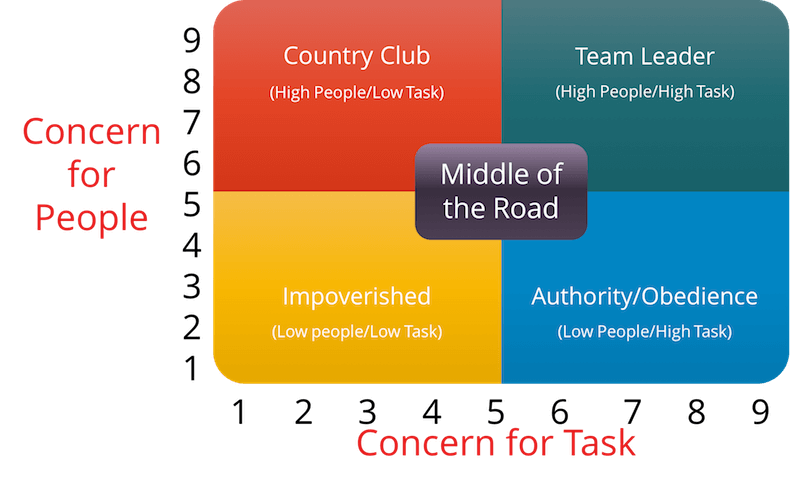What would your first priority be after recruiting a new team member? Would it be to get each member focused on tasks in order to meet set goals and objectives? Or, would you rather try to understand each team member’s unique abilities so you can apportion tasks that would match their strength?

Experience has shown that no one leadership approach is best fit for all situations. Therefore, it becomes necessary to know of what your most natural approach would be so that you can develop new skills and improve your leadership qualities.
This article is centered on theories that have been developed to allow leaders match their behaviors with performance.
Leadership Grid Theory
Developed in 1950s by management theorists Robert Blake and Jane Mouton, this model of behavioral leadership is based on two behavioral dimensions consisting of “concern for people” and “concern for results”. The first is plotted on the x-axis of a graph on a scale of 1 to 9, while the other is plotted on the y-axis using similar scale.

What Leadership Grid Entails
The Managerial Grid theory helps you consider your leadership qualities and how it affects your team’s productivity and motivation.
Understanding the Blake and Mouton Leadership Grid Theory
Leadership grid focuses attention on attitudes perceived to be the drive behind particular behavior. The leadership grid is based on two leadership dimensions called: “concern for people” and “concern for result”. Blake and Mouton proposes that these two attitudes are independent of each other; therefore, both reside in a leader who operates with a given approach as will be described in the course of this article.
- Concern for people: This concerns the degree to which a leader considers team members’ needs, interests and areas of personal development when deciding the best ways by which tasks can be completed.
- Concern for results: This is the degree to which a leader emphasizes concrete objectives, high productivity and organizational efficiency when deciding the best procedures to accomplishing a task.
The Blake and Macanese leadership grid theory identified five leadership strategies based on the dimensions listed above. We’re going to look at the leadership grid examples with emphases on its inherent characteristics and results achieved.
- “Impoverished Leadership” Model
This leadership grid model shows little regard for team or production, but rather pays more attention to self-preservation within the organization. The manager has very little interest in creating systems that gets the job done. He isn’t very keen to motivating team members thus, achieves an apparent result that connotes disorganization, dissatisfaction and disharmony.
- “Produce or Perish” Leadership Model
This model features a resolve to stick to production schedules with gross disregard for the needs of workers or the team. A manager who implements this method will experience high attrition within the team due to inconsideration and neglect of their wellbeing of his workers.
- “Middle of the Road” Leadership
This method strives for a balance between speaking for the teams needs as well as the organization’s needs for production. One major challenge of this model is that it rarely ever adequately fulfils either process and leads to average or below average results both in schedule performance and satisfaction.
- “Country Club” Leadership
This approach prioritizes the teams needs above anything else. The leader works by the assumption that happiness within the team would naturally lead to improved productivity. However, it doesn’t serve as a guarantee that marginal results may not be achieved.
- The “Team” Approach
Considered to be the most effective form of leadership by promulgators of the leadership grid theory. The team approach portrays a leader who shows just as much commitment and resolve to staff empowerment as they would towards increased productivity. This mindset is informed by the thought that motivating workers to operate as a team will lead to greater accomplishments.
Related links…
Different between Leadership and Management
Situational Leadership Model
This is yet another timeless and reputable framework based on the relationship between leaders and followers. It enables leaders to match their behaviors with the performance needs of individuals as well as groups they intend to influence.
Benefits of Situational Leadership Grid
- Creates a common language of performance.
- Accounts for multi-directional influence
- Accelerate the pace and quality of employee development
- Allow leaders to effectively drive behavioral change
- Teach leaders to accurately interpret and effectively respond to their environment
Related links…
One tool that can effectively allow leaders communicate seamlessly, coordinate work streams and better influence team members is the Sinnaps, project management software. It is incorporated with all the modern features that make for better collaboration between teams including but not limited to improved communication between team members, information sharing, team building, encouraging openness and resource sharing, etc. This tool can help leaders achieve increased efficiency, employee satisfaction and most importantly facilitates the achievement of set goals and objectives.

